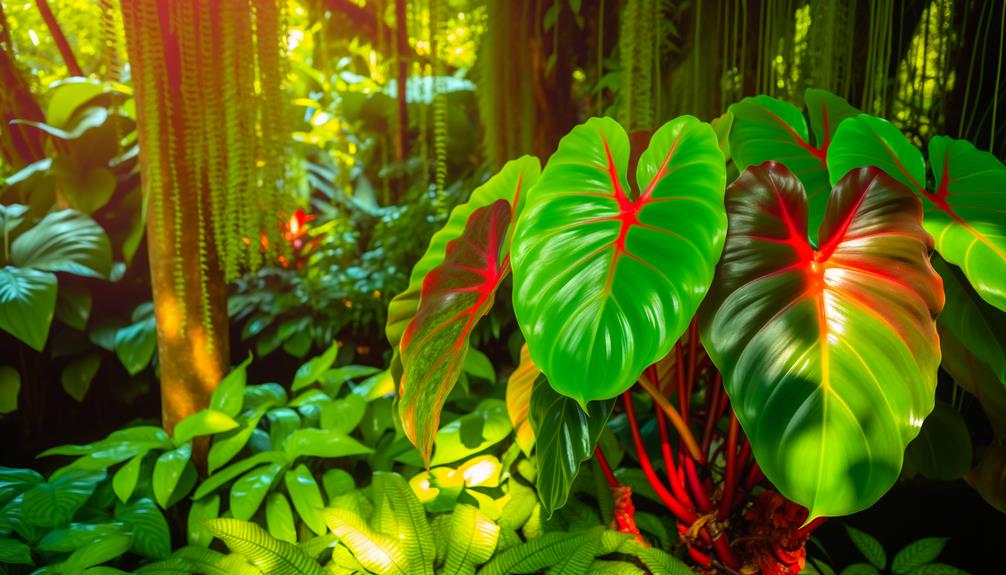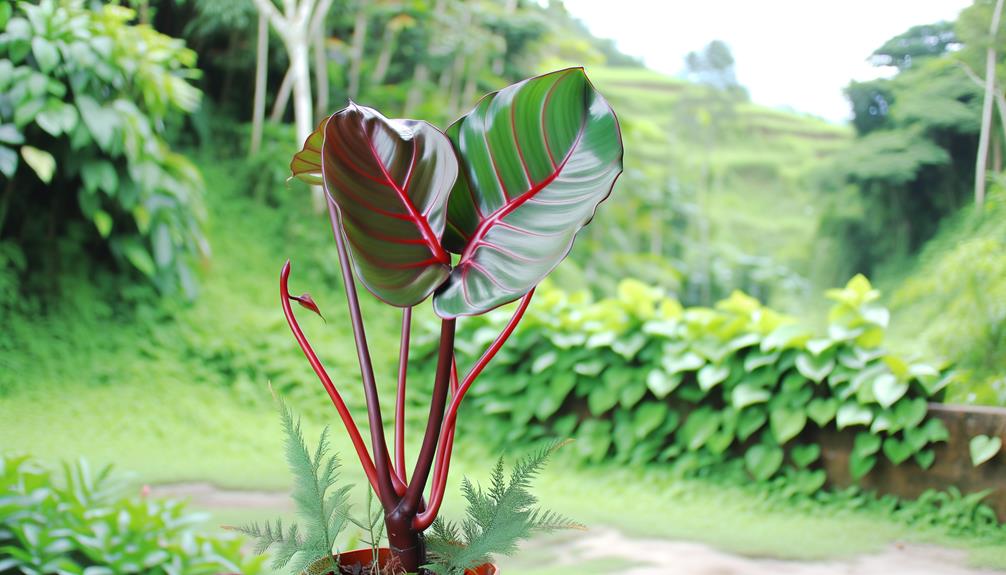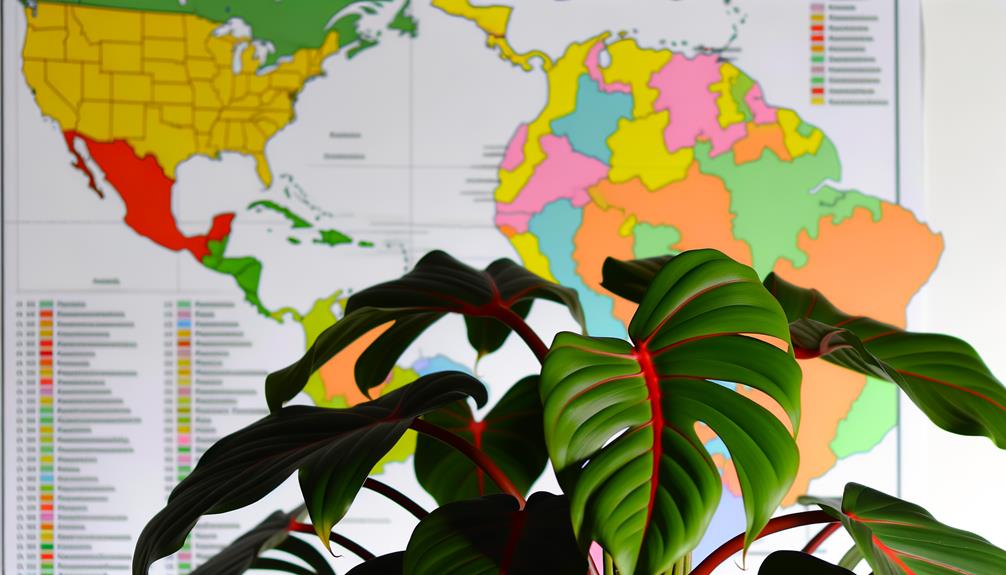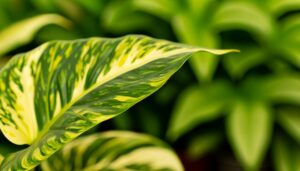What Is the Common Name of the Philodendron Erubescens in Spanish (Nombre Común)?
The Philodendron erubescens, a member of the Araceae family, is commonly known as 'Filodendro Rojo' in Spanish. This name highlights its characteristic vibrant red-tinted foliage.
Native to the tropical regions of South America, the Philodendron erubescens thrives in humid, shaded environments and is often used for ornamental purposes due to its aesthetic appeal. The nomenclature 'Filodendro Rojo' encompasses both the botanical and cultural significance of this species.
Additionally, regional variations exist, such as 'Filodendro Trepador' in Colombia and 'Filodendro Sangrante' in Argentina. For more intricate details on its care and significance, further information awaits.

Key Takeaways
- The common name of Philodendron erubescens in Spanish is 'Filodendro Rojo'.
- The name 'Filodendro Rojo' translates to 'Red Philodendron' in English.
- It is also known as 'Filodendro Trepador' in Colombia.
- In Argentina, it is referred to as 'Filodendro Sangrante'.
- The Spanish names highlight the plant's distinctive red-tinted leaves.
Plant Overview

Philodendron erubescens, commonly known as 'Philodendron rojo' in Spanish, is an evergreen climbing plant belonging to the Araceae family. This species is characterized by its robust, heart-shaped leaves that exhibit a strikingly vibrant red to deep green gradient, contributing to its aesthetic appeal.
The plant's stems are typically reddish, hence the name 'rojo,' meaning red in Spanish. Native to the tropical regions of South America, Philodendron erubescens thrives in humid, shaded environments. It employs aerial roots to cling to surfaces, facilitating vertical growth.
The plant is frequently used in indoor horticulture due to its minimal maintenance requirements and ability to improve air quality. Its adaptability and ornamental foliage make it a popular choice among plant enthusiasts.
Botanical Name
The species Philodendron erubescens, known scientifically as Philodendron erubescens K. Koch & Augustin, derives its botanical name from the Latin words 'erubescens,' meaning blushing, and 'Philodendron,' which translates to 'tree lover.' This nomenclature aptly reflects both the plant's vibrant foliage and its climbing nature.
The genus Philodendron belongs to the Araceae family, characterized by their heart-shaped leaves and vigorous growth habits. Philodendron erubescens is distinguished by its glossy, red-tinted leaves and robust, vining stems. The plant's taxonomy underscores its ecological adaptations, including aerial roots for support and nutrient absorption.
Understanding the botanical name helps in identifying the species accurately, aiding in its cultivation, care, and research within botanical and horticultural contexts.
Common Names

In Spanish-speaking regions, the species is commonly referred to as 'Filodendro Rojo,' aptly named for its striking red-tinted foliage. This nomenclature reflects the vivid hues present in the leaves and stems, which are characteristic of the Philodendron erubescens.
The term 'rojo' directly translates to 'red,' highlighting the plant's notable coloration. This common name facilitates easier identification and communication among horticulturists and plant enthusiasts.
The 'Filodendro Rojo' is frequently utilized in interior landscaping due to its aesthetic appeal and adaptability to indoor environments. Its robust nature and visually appealing features make it a popular choice.
Understanding these common names enhances the appreciation and recognition of this species within botanical and horticultural contexts.
Spanish Moniker
The Spanish moniker for Philodendron erubescens, commonly referred to as 'Filodendro rojo,' encapsulates both its vibrant red hues and its botanical characteristics.
This nomenclature not only reflects its cultural significance within Spanish-speaking regions, where it is revered for its ornamental appeal, but also underscores its prevalent usage in gardening practices.
Understanding these aspects provides valuable insights into its horticultural and social relevance.
Common Spanish Nickname
A prevalent Spanish moniker for Philodendron erubescens is 'Filodendro Rojo,' reflecting its characteristic red-tinted foliage. This appellation is derived from the Latin 'erubescens,' meaning 'reddening,' which aptly describes the plant's distinctive reddish hues.
The term 'Filodendro' is a transliteration of 'Philodendron,' indicating its taxonomic classification within the Araceae family. The red pigmentation is primarily observed in the petioles and undersides of the leaves, resulting from the presence of anthocyanin compounds.
This coloration not only enhances its aesthetic appeal but also contributes to its popularity as an ornamental plant. The name 'Filodendro Rojo' serves both as a descriptive identifier and as a means of distinguishing this species from other Philodendron varieties within horticultural contexts.
Cultural Significance
Renowned for its vibrant red foliage, the Spanish moniker 'Filodendro Rojo' encapsulates both the visual allure and cultural resonance of Philodendron erubescens within Spanish-speaking communities.
The term 'Rojo,' meaning red, emphasizes the plant's strikingly hued leaves, which symbolize passion and crucial in many Latin cultures. This plant is often associated with themes of love and energy, reflecting its vivid coloration.
In various cultural contexts, 'Filodendro Rojo' is not merely an ornamental species but a botanical emblem of emotional intensity and dynamism. Its popularity in domestic spaces further underscores its role in enhancing aesthetic and emotional atmospheres, contributing to its revered status within these communities.
Usage in Gardening
In Spanish-speaking horticulture, 'Filodendro Rojo' is highly valued for its robust growth and adaptability, making it a preferred choice for both novice and experienced gardeners.
This perennial climbing plant thrives in a variety of light conditions, from indirect sunlight to partial shade, enhancing its versatility in garden design.
Its striking red-tinged stems and lush, heart-shaped leaves contribute to its ornamental appeal, while its minimal maintenance requirements, such as sporadic watering and occasional pruning, make it user-friendly.
Additionally, 'Filodendro Rojo' exhibits a high resistance to common pests and diseases, further solidifying its status as an ideal addition to both indoor and outdoor horticultural settings.
Its ability to purify air adds functional value to its aesthetic charm.
Regional Variations

Regional variations in the common name of Philodendron erubescens in Spanish-speaking countries are influenced by geographic naming disparities, cultural nuances, and the evolution of common names over time.
These variations often reflect local linguistic peculiarities and historical interactions with the plant species.
Understanding these factors is essential for accurately identifying and communicating about the plant across diverse Spanish-speaking regions.
Geographic Naming Differences
Across various regions, the common name of Philodendron erubescens in Spanish exhibits significant variations, reflecting the plant's diverse cultural and linguistic contexts.
In Mexico, it is often referred to as 'Filodendro Rojo' due to its distinctive red stems and leaves.
Moving south to Colombia, the term 'Filodendro Escarlata' is more prevalent, emphasizing the plant's striking scarlet hues.
In Argentina, the name 'Filodendro Rosa' is commonly used, highlighting the pinkish undertones in the foliage.
These regional differences are not merely linguistic but also indicative of local horticultural practices and botanical traditions.
Such nomenclature variations underscore the importance of geographic context in the botanical identification and classification of plant species within the Spanish-speaking world.
Cultural Influences on Naming
The naming conventions for Philodendron erubescens in Spanish-speaking regions are profoundly shaped by cultural practices, historical influences, and local botanical knowledge.
In various Latin American countries, the names assigned to this plant often reflect its aesthetic attributes and utility in traditional medicine. For instance, the term 'filodendro rojo' (red philodendron) highlights the plant's distinctive reddish stems. Indigenous communities may incorporate native terminology, blending local dialects with Spanish, thereby preserving cultural heritage.
Additionally, the historical exchange of botanical knowledge between Spain and its former colonies has further diversified naming practices. Regional variations in climate and flora also contribute to unique local nomenclature, illustrating a tapestry of cultural and environmental interactions influencing the common names of Philodendron erubescens.
Common Names Evolution
How do the common names of Philodendron erubescens evolve in different Spanish-speaking regions, reflecting a dynamic interplay of ecological adaptations and cultural interpretations? The nomenclature of this species varies greatly, influenced by local ecosystems and cultural heritage. For instance, in Mexico, it may be referred to as 'Filodendro Rojo' due to its reddish stems. In Colombia, it's known as 'Filodendro Trepador,' highlighting its climbing nature. Meanwhile, in Argentina, the term 'Filodendro Sangrante' is used, emphasizing its sap characteristics.
| Region | Common Name |
|---|---|
| Mexico | Filodendro Rojo |
| Colombia | Filodendro Trepador |
| Argentina | Filodendro Sangrante |
These variations underscore the importance of regional ecological and cultural contexts in shaping the common names of Philodendron erubescens.
Cultural Significance
Philodendron erubescens, commonly known as 'filodendro rojo' in Spanish, holds significant cultural value in various Latin American communities, where it is often associated with concepts of prosperity and well-being.
This species, characterized by its striking reddish stems and lush green foliage, is frequently utilized in traditional rituals and domestic settings to symbolize growth and positive energy.
The plant's aesthetic appeal also contributes to its popularity, as it is believed to enhance the ambiance of living spaces, thereby fostering an environment conducive to health and happiness.
Moreover, its robust nature and low maintenance requirements make it an ideal candidate for ornamental use, reinforcing its role as a symbol of endurance and resilience in cultural contexts.
Care Tips

Ensuring ideal growth for Philodendron erubescens involves maintaining a balance of indirect sunlight, consistent moisture levels, and well-draining soil. Position this plant in areas receiving bright, indirect light to prevent leaf scorching.
The potting medium should retain moisture without becoming waterlogged, utilizing a mixture of peat, perlite, and orchid bark. Regular watering is essential, allowing the top inch of soil to dry between waterings to avoid root rot.
Humidity levels around 60-70% are most suitable; consider using a humidifier or pebble tray. Fertilize bi-monthly during the growing season with a balanced, water-soluble fertilizer diluted to half strength.
Pruning dead or yellowing leaves promotes healthy growth and aesthetic appeal, ensuring the Philodendron erubescens thrives.
Popularity in Homes
The widespread popularity of Philodendron erubescens in residential interiors can be attributed to its striking foliage, ease of care, and adaptability to various indoor environments.
The plant's vibrant, heart-shaped leaves with a glossy texture provide an aesthetic appeal that enhances interior décor. Its ability to thrive in low to moderate light conditions and tolerate occasional neglect makes it an ideal choice for busy homeowners.
Additionally, Philodendron erubescens exhibits robust growth and resilience against common pests, further contributing to its desirability. This species also improves indoor air quality by filtering airborne toxins, offering a practical benefit alongside its ornamental value.
Consequently, its versatility and low maintenance requirements have cemented its status as a preferred houseplant in many households.
Conclusion
In conclusion, Philodendron erubescens, known informally in Spanish as 'Filodendro rojo,' stands as a botanical gem, exuding both visual charm and ecological importance. This lush wonder, with its heart-shaped leaves tinged with a hint of crimson, embodies the essence of natural beauty and adaptability.
Its cultural importance and simple maintenance make it a cherished feature in homes. Hence, it stays a constant confirmation of the harmonious combination of form and function in plant life.






